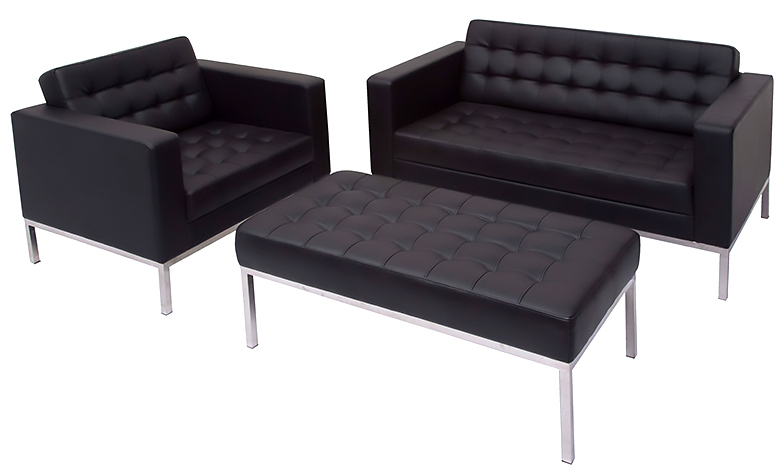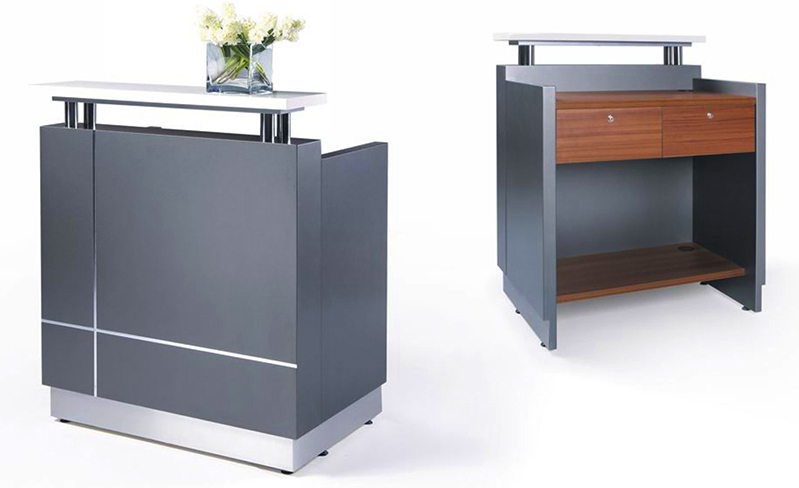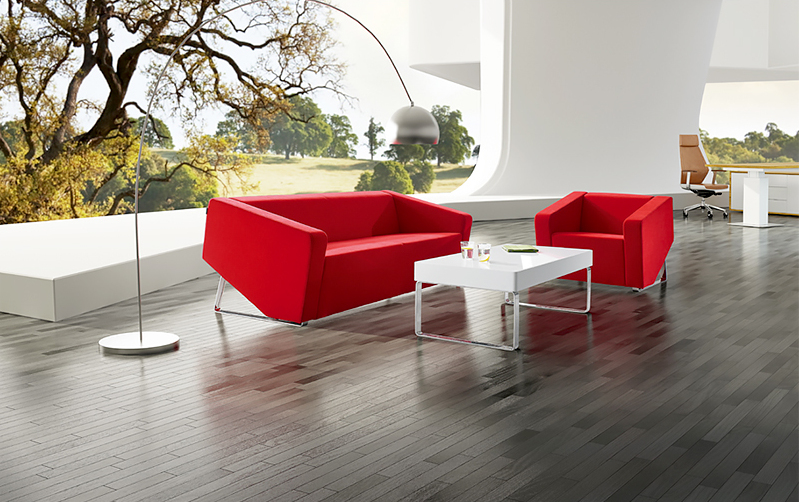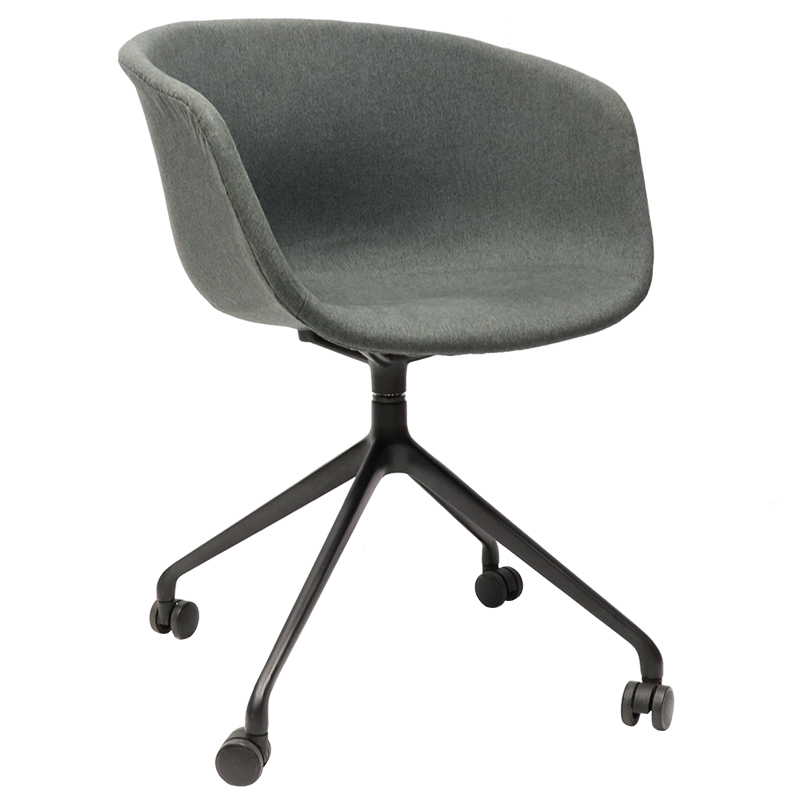Last updated on June 2nd, 2024
People who use waiting rooms do so for a range of different reasons. If it is a medical waiting room, they could be feeling unwell or accompanying a loved one who is ill. They could be feeling anxious, concerned, or fearful. They could also experience feelings of impatience or even anger if kept waiting for too long. If they are visiting a business to present a sales pitch or to attend a job interview, they may be feeling excited, uneasy, or stressed. No one enjoys waiting, so setting up a small waiting room in a tasteful and mindful way can go a long way to helping people relax and feel less anxious, whatever the reason they may be there.

Genoa Chair 2 Seater Lounge and Ottoman Package
Recommendations for Small Waiting Rooms in 2023:
1. Give Importance to The Decoration:
The décor in a waiting room is crucial to achieving a calm and restful atmosphere. Choosing a soothing color scheme is the most important starting point. Blues, greens, and neutrals create a soft backdrop for soft furnishings like waiting room chairs or reception chairs, rugs, artwork, and another décor.
2. Lighting Can Help You Set Up The Perfect Place:
Lighting is also crucial and should be soft and unobtrusive to engender feelings of peace and serenity. Bright, harsh lights tend to jar the senses and create feelings of unease and disquiet. Keeping the waiting room clean and fresh will also enable guests to relax and feel more at home. Alleviate any unpleasant odors by using a discreet air freshener that removes smells rather than one that leaves a strong, overwhelming, and sometimes unpleasant scent behind.
3. Establish Welcoming Desks:
Your reception desk should be a focal point. This is where patients or customers will first report to announce their arrival and receive their initial updates or instructions. Installing an attractive reception desk offering easy access to the receptionist is very important. There is nothing worse than having visitors struggle to find the person who is their first point of contact because the reception desks are hard to find or so tall that they have to peer over the top to speak to the receptionist.

Una-Compact Reception Desk
4. Organize Your Chairs in a Frame:
Waiting Room Chairs or Reception Chairs should be tastefully placed in different-sized clusters so that couples, families, or groups are able to sit near each other. There should also be some single chairs for people on their own as they may not want to engage with others in this situation. Careful seat placement can really help alleviate some of the stress of being in a waiting room.
Waiting Room Chairs and Reception Chairs should be solid and comfortable. They will need to suit a wide range of people, encompassing different demographics, age groups, genders, sizes, and shapes. Having chairs that have a sturdy construction, have arms for support, and are upholstered in a comfortable fabric that can be easily disinfected and wiped down is paramount. A selection of the same range of chairs upholstered in fabrics that are from the same tonal family, instead of using the same color for all the chairs, can break the monotony and add a bit of flair and interest to the overall look.
5. The Ideal Place to Entertain:
Adding a small play area for children in a corner where appropriate can be a big stress reliever for parents. Busy children are usually quieter and more engaged – all positive for a busy waiting room. A television set can also provide some distraction and entertainment, especially for younger patients. However, older visitors may also find a television set a welcome option as magazines are no longer offered in many waiting rooms due to hygiene issues surrounding the COVID-19 virus.

Helena Lounge and Chairs with Cooper Coffee Table Package
6. Putting Attractive Pieces of Art:
The use of artfully placed mirrors can make a small waiting room look a lot bigger and displaying some large, calming artworks or photographs of a beach or forest scene, can add to the overall soothing effect. Using sound-absorbing fabric tiles on one or part of the walls can also help reduce and soften noise that adds to the cozy, welcoming atmosphere.
Using plants or even a small fish tank if you have the space, can create a beautiful, natural effect that has a calming effect on the majority of people.
7. High-Speed Wifi:
Offering a free Wi-Fi Connection and a few charging stations can distract visitors and help them stay connected to friends and family who are not with them. There are many options for charging devices on the market today. Choosing a simple, effective and easily accessible range for your waiting room will make a great deal of difference to your visitors.
8. Placards for Instruction:
Education leaflets in medical waiting rooms which people can read and take away with them are very important as anxious people often do not absorb everything they are told. Having these on offer can give patients confidence in the knowledge that they have all the information they need when they leave,
9. Digital Queue Management:
Digital Queue Management uses technology to streamline and organize customer queues. It enables virtual queuing, real-time updates, and personalized notifications, improving customer experience and operational efficiency. Implement digital queue management systems that allow visitors to check in remotely or through kiosks. This reduces the number of people physically present in the waiting room at any given time. It helps in optimizing the space, reduces wait times, enhances customer satisfaction, and ensures organized and efficient service flow in small rooms. It streamlines customer management, improves resource allocation, and provides real-time insights for better decision-making.
 10. Flexible Arrangement:
10. Flexible Arrangement:
Flexible arrangements in a small waiting room offer improved space utilization, reduced crowding, enhanced comfort, and adaptable seating options. This fosters a more pleasant and efficient environment for visitors while accommodating varying needs and maximizing the utility of limited space. Opt for lightweight, easily movable chairs, or chairs on castors. This way, you can rearrange the seating layout quickly to accommodate different numbers of people or to create more space for specific activities. These pieces are designed to maximize space while offering comfort, making the most of the limited area.
Conclusion:
The experts say you only have one shot to create a great first impression and there is no arguing with this bit of wisdom. Your waiting room should immediately create the right ambiance to impress people and make them feel welcome and relaxed. Having a waiting room that is clean, fresh, and attractive will instantly lift a visitor’s mood. You can also enhance this atmosphere by choosing the right office furniture color scheme, lighting, calming artwork, and the appropriate waiting room chairs or reception chairs. Offering distractions like a television set, children’s play corner, free Wi-Fi and/or charging stations, and education leaflets will keep people more engaged and less stressed.
Visiting a waiting room for most people is not their favorite experience. Many people feel uneasy and anxious and cannot wait to get back home. To make your visitor experience better you can also check 5 things to consider while choosing waiting room chairs, which will help you to make your visitor room more comfortable
If we can alleviate these feelings to some degree and make our visitors feel comfortable and relaxed, we will have gone a long way to elevating their experience in our waiting room and making it as positive as possible.



 10. Flexible Arrangement:
10. Flexible Arrangement:







